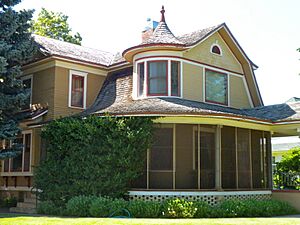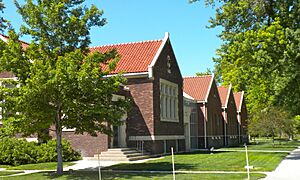Gothenburg, Nebraska facts for kids
Quick facts for kids
Gothenburg, Nebraska
|
|
|---|---|

Pony Express station in Ehmen Park, Gothenburg
|
|

Location of Gothenburg, Nebraska
|
|
| Country | United States |
| State | Nebraska |
| County | Dawson |
| Area | |
| • Total | 3.68 sq mi (9.52 km2) |
| • Land | 3.63 sq mi (9.41 km2) |
| • Water | 0.04 sq mi (0.12 km2) |
| Elevation | 2,559 ft (780 m) |
| Population
(2020)
|
|
| • Total | 3,478 |
| • Density | 957.60/sq mi (369.75/km2) |
| Time zone | UTC-6 (Central (CST)) |
| • Summer (DST) | UTC-5 (CDT) |
| ZIP code |
69138
|
| Area code(s) | 308 |
| FIPS code | 31-19385 |
| GNIS feature ID | 2394936 |
| Website | http://www.ci.gothenburg.ne.us/ |
Gothenburg is a city in Dawson County, Nebraska, United States. It is part of the Lexington, Nebraska Micropolitan Statistical Area. The population was 3,574 at the 2010 census.
Contents
History
Gothenburg, Nebraska is named after Gothenburg, Sweden, and is noted for its large number of residents of Swedish descent. Gothenburg, Nebraska, and Gothenburg (Swedish: Göteborg), Sweden, are believed to be the only two cities named Gothenburg in the world.
Gothenburg was founded in 1882 by Olof Bergstrom. After coming to America from Sweden in 1881, Bergstrom worked for a time on the Union Pacific Railroad, then homesteaded in Dawson County near Gothenburg. He eventually became a land agent for the UP. Bergstrom selected the site that was to become Gothenburg and located a farmstead about a mile north. The Union Pacific Railroad laid out the original town of eight blocks parallel to the railroad tracks. Bergstrom made several return trips to Sweden to lead groups of settlers to Dawson County.
Geography
According to the United States Census Bureau, the city has a total area of 3.64 square miles (9.43 km2), of which 3.59 square miles (9.30 km2) is land and 0.05 square miles (0.13 km2) is water.
Climate
| Climate data for Gothenburg, Nebraska (1991–2020 normals, extremes 1894–present) | |||||||||||||
|---|---|---|---|---|---|---|---|---|---|---|---|---|---|
| Month | Jan | Feb | Mar | Apr | May | Jun | Jul | Aug | Sep | Oct | Nov | Dec | Year |
| Record high °F (°C) | 77 (25) |
79 (26) |
92 (33) |
101 (38) |
103 (39) |
110 (43) |
116 (47) |
109 (43) |
107 (42) |
104 (40) |
85 (29) |
76 (24) |
116 (47) |
| Mean maximum °F (°C) | 61.6 (16.4) |
65.8 (18.8) |
77.6 (25.3) |
85.3 (29.6) |
90.3 (32.4) |
96.6 (35.9) |
100.0 (37.8) |
97.8 (36.6) |
93.3 (34.1) |
84.9 (29.4) |
72.7 (22.6) |
62.3 (16.8) |
101.4 (38.6) |
| Mean daily maximum °F (°C) | 38.8 (3.8) |
42.2 (5.7) |
54.1 (12.3) |
62.9 (17.2) |
72.4 (22.4) |
82.9 (28.3) |
87.6 (30.9) |
85.2 (29.6) |
78.2 (25.7) |
64.8 (18.2) |
51.2 (10.7) |
40.3 (4.6) |
63.4 (17.4) |
| Daily mean °F (°C) | 27.5 (−2.5) |
30.3 (−0.9) |
40.7 (4.8) |
49.7 (9.8) |
60.3 (15.7) |
70.7 (21.5) |
75.5 (24.2) |
73.4 (23.0) |
65.0 (18.3) |
51.7 (10.9) |
38.7 (3.7) |
28.8 (−1.8) |
51.0 (10.6) |
| Mean daily minimum °F (°C) | 16.1 (−8.8) |
18.5 (−7.5) |
27.4 (−2.6) |
36.6 (2.6) |
48.2 (9.0) |
58.5 (14.7) |
63.4 (17.4) |
61.5 (16.4) |
51.9 (11.1) |
38.6 (3.7) |
26.3 (−3.2) |
17.3 (−8.2) |
38.7 (3.7) |
| Mean minimum °F (°C) | −6.7 (−21.5) |
−3.5 (−19.7) |
6.6 (−14.1) |
19.2 (−7.1) |
31.7 (−0.2) |
45.0 (7.2) |
52.2 (11.2) |
49.6 (9.8) |
35.6 (2.0) |
20.1 (−6.6) |
6.8 (−14.0) |
−4.2 (−20.1) |
−12.3 (−24.6) |
| Record low °F (°C) | −29 (−34) |
−33 (−36) |
−21 (−29) |
−3 (−19) |
18 (−8) |
33 (1) |
40 (4) |
36 (2) |
20 (−7) |
2 (−17) |
−14 (−26) |
−40 (−40) |
−40 (−40) |
| Average precipitation inches (mm) | 0.38 (9.7) |
0.64 (16) |
1.10 (28) |
2.70 (69) |
4.11 (104) |
3.68 (93) |
3.37 (86) |
3.29 (84) |
1.72 (44) |
1.86 (47) |
0.72 (18) |
0.56 (14) |
24.13 (613) |
| Average snowfall inches (cm) | 4.6 (12) |
5.2 (13) |
5.1 (13) |
1.6 (4.1) |
0.2 (0.51) |
0.0 (0.0) |
0.0 (0.0) |
0.0 (0.0) |
0.0 (0.0) |
0.6 (1.5) |
2.4 (6.1) |
4.5 (11) |
24.2 (61.21) |
| Average precipitation days (≥ 0.01 in) | 4.4 | 4.8 | 6.5 | 8.5 | 10.9 | 9.3 | 8.7 | 8.3 | 5.8 | 6.4 | 4.4 | 3.4 | 81.4 |
| Average snowy days (≥ 0.1 in) | 2.6 | 2.8 | 2.3 | 0.6 | 0.1 | 0.0 | 0.0 | 0.0 | 0.0 | 0.2 | 1.1 | 2.4 | 12.1 |
| Source: NOAA (snow, snow days 1894–2013) | |||||||||||||
Demographics
| Historical population | |||
|---|---|---|---|
| Census | Pop. | %± | |
| 1890 | 535 | — | |
| 1900 | 819 | 53.1% | |
| 1910 | 1,730 | 111.2% | |
| 1920 | 1,754 | 1.4% | |
| 1930 | 2,322 | 32.4% | |
| 1940 | 2,330 | 0.3% | |
| 1950 | 2,977 | 27.8% | |
| 1960 | 3,050 | 2.5% | |
| 1970 | 3,158 | 3.5% | |
| 1980 | 3,479 | 10.2% | |
| 1990 | 3,232 | −7.1% | |
| 2000 | 3,619 | 12.0% | |
| 2010 | 3,574 | −1.2% | |
| 2020 | 3,478 | −2.7% | |
| U.S. Decennial Census 2012 Estimate |
|||
2010 census
At the 2010 census there were 3,574 people in 1,494 households, including 974 families, in the city. The population density was 995.5 inhabitants per square mile (384.4/km2). There were 1,664 housing units at an average density of 463.5 units per square mile (179.0 units/km2). The racial makeup of the city was 97.3% White, 0.2% African American, 0.3% Native American, 0.3% Asian, 0.8% from other races, and 1.2% from two or more races. Hispanic or Latino of any race were 4.8%.
Of the 1,494 households 33.5% had children under the age of 18 living with them, 51.7% were married couples living together, 9.8% had a female householder with no husband present, 3.7% had a male householder with no wife present, and 34.8% were non-families. 31.4% of households were one person and 16.1% were one person aged 65 or older. The average household size was 2.34 and the average family size was 2.94.
The median age was 40.4 years. 27.1% of residents were under the age of 18; 5.7% were between the ages of 18 and 24; 22.5% were from 25 to 44; 25.2% were from 45 to 64; and 19.4% were 65 or older. The gender makeup of the city was 47.3% male and 52.7% female.
Points of interest


- The Pony Express Trail runs through Gothenburg. There are two original Pony Express Stations in Gothenburg. In 1931, a station located on the Upper 96 Ranch, four miles east of Fort McPherson in Lincoln County, was donated to the city. The station was moved to Ehmen Park in central Gothenburg. A second station, Midway Stage Station, is still in its original location, on the Lower 96 Ranch four miles south of Gothenburg; it is open to the public on a limited basis.
- The Dissected Loess Plains, an unusual geological and ecological feature that has been granted status as a National Natural Landmark, is waymarked in Gothenburg.
- Swedish Crosses Cemetery, a cemetery where wrought iron crosses mark the graves of three children of Swedish immigrants is located two miles north and two miles west of Gothenburg. A Nebraska Historical Marker was dedicated in August 1991.
- The Gothenburg Historical Museum, organized in 1980, contains many historical artifacts from the Dawson County area.
- The Sod House Museum was established in Gothenburg in 1988. The museum stands next to a full-scale replica of an authentic sod house, together with a barn, windmills and life-sized barbed wire sculptures.
Notable people
- Chris Dishman, professional American football player, was born in Gothenburg
- Ben Kuroki, the only Japanese-American to serve in the US Army Air Force in the Pacific during World War II, was born in Gothenburg
- Jay Novacek, professional football player, attended Gothenburg High School
- Louise Odencrantz, social scientist
See also
 In Spanish: Gothenburg (Nebraska) para niños
In Spanish: Gothenburg (Nebraska) para niños


